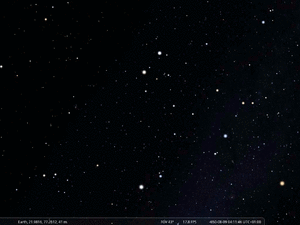Punarvasu: Difference between revisions
From All Skies Encyclopaedia
Punarvasu
(Created page with "{{DISPLAYTITLE:}} ... is an Indian name, used by the Indian Vedic tradition. Most of these names are roughly 3000 years old. They pre-date Hinduism but were taken over by it. ==Etymology and History== What does the term mean, does it always have the same meaning - was it changed over time. === Origin of Constellation === === Transfer and Transformation of the Constellation === == Mythology == mnemonic tales and cultural significance == Weblinks == * {{NAMESPACE...") Tag: Disambiguation links |
No edit summary |
||
| (8 intermediate revisions by the same user not shown) | |||
| Line 1: | Line 1: | ||
{{DISPLAYTITLE:}} |
{{DISPLAYTITLE:Punarvasu (पुनर्वसु)}} |
||
[[File:7 Punarvasu draw.png|thumb|Punarvasu asterism consisting of four stars, the brightest ones being alpha and beta Geminorum.]] |
|||
| ⚫ | |||
[[File:7 Punarvasu stellarium.gif|thumb|Punarvasu, 7th Nakshatra, mapped to the Stellarium star chart.]] |
|||
| ⚫ | |||
==Etymology and History== |
==Etymology and History== |
||
'''Name Variants''' |
|||
What does the term mean, does it always have the same meaning - was it changed over time. |
|||
* Punarvasu (the two restorers), |
|||
* Yamakau ("the two chariots") |
|||
* Aditerbha |
|||
[[File:Tibet nakshatra 05.png|thumb|Tibet nakshatra 05]] |
|||
=== Origin of Constellation === |
=== Origin of Constellation === |
||
The name of the constellations is grammatically a dual, so it points to two similar stars/ asterisms. This way, it equals the idea of the Greco-Roman and Mesopotamian Twin-constellation where two bright stars head two similar, parallel chains of stars. |
|||
4 stars: α, β Geminorum are certain; the other two might be ε, ζ Gem |
|||
=== Transfer and Transformation of the Constellation === |
=== Transfer and Transformation of the Constellation === |
||
| Line 24: | Line 34: | ||
[[Category:Indian]] [[Category:Asterism]] [[Category:Constellation]][[Category:Eurasia]][[Category:South Asian]] |
[[Category:Indian]] [[Category:Asterism]] [[Category:Constellation]][[Category:Eurasia]][[Category:South Asian]] |
||
[[Category:Zodiac]] |
|||
Latest revision as of 06:55, 14 October 2025
Punarvasu (पुनर्वसु), "the twin-restorers of goods", is an Indian name, used by the Indian Vedic tradition. Most of these names are roughly 3000 years old. They pre-date Hinduism but were taken over by it.
Etymology and History
Name Variants
- Punarvasu (the two restorers),
- Yamakau ("the two chariots")
- Aditerbha
Origin of Constellation
The name of the constellations is grammatically a dual, so it points to two similar stars/ asterisms. This way, it equals the idea of the Greco-Roman and Mesopotamian Twin-constellation where two bright stars head two similar, parallel chains of stars.
4 stars: α, β Geminorum are certain; the other two might be ε, ζ Gem
Transfer and Transformation of the Constellation
Mythology
mnemonic tales and cultural significance
Weblinks
References
- References (general)







